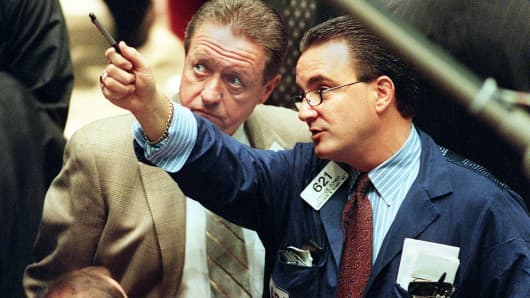
The S&P 500 has a big performance issue that should be a focus for investors: Too much of the index return is coming from too few of its stocks.
The 10 most valuable companies in the market are up roughly 21.4 percent as a group this year, versus a loss of 2.6 percent for the rest of the stock market.
That 24 percentage-point spread between the biggest stocks and the index as a whole is the widest since 1999, heading into the dot-com bust.
“If narrow leadership stumbles, there’s not much support,” said S&P Capital IQ strategist Sam Stovall.
That leadership comes primarily from a few tech stocks.
Shares of Microsoft, Amazon.com, Alphabet and Facebook have led the way, while Johnson & Johnson, Berkshire Hathaway andExxonMobil have turned in lackluster performance. The only non-tech stock to deliver among the biggest S&P 500 stocks is GE.
(Note to chart: These are the 10 largest stocks in the S&P 500 by market cap. Alphabet is No. 11 when ranked by index weighting. Source: S&P Capital IQ)
“A widening of the spread between the market’s best performers and the rest of the market should be viewed as a cautionary sign,” wrote Jason Trennert of Strategas Research Partners in a recent note to clients, citing research conducted by Strategas partner and chief technical analyst Chris Verrone.
The S&P 500 margin expansion story is as troubling. In the post-2009 bull market, half of the margin growth in the index has come from tech stocks — 69 companies out of the 500. And 20 percent has come fromApple alone, according to recent research from Goldman Sachs.
The data is critical for an investor’s next steps, because the maxim to “Sell in May and go away” turned out to be prescient — with a flat market over the past six months — and now is when investors can make choices in time for winter months that typically lead upward moves in stocks, Stovall said.
“If narrow leadership stumbles, there’s not much support.”
Goldman Sachs strategist David Kostin wrote in a recent note that the moves in tech and Apple made sense because the industry, led by its most valuable company, was sharply improving profit margins, but that widening in margins is expected to slow down in the next year.
The problem with concentrated returns is that it convinces investors that stocks are less risky than they are, said Mitch Goldberg, president of ClientFirst Strategy, an advisory firm based in Boca Raton, Florida.
“This has been a year of mega-cap stocks because investors are feeling insecure and there’s an element of safety in the brand names, but the big risk is the top 10 collapse, similar to 2000,” Goldberg said. “As soon as momentum stops, the investors that came in late will decide to bail. And then it becomes a self-fulfilling prophecy of momentum that is as strong on the way down as on the way up.”
The big question is, what to do about it?
Goldberg advises clients to not wait too long to make a move on booking profits. “If you’re up 50 percent and get out up 44 percent, no one will complain,” he said. He advises use of limit orders as a way to force buying and selling discipline on stock investors.
“Just investing in the top 10 hasn’t been a consistently successful strategy,” he said.
Kostin predicts a “bifurcated market” in which the overall market will look flat but there will be clear gaps between high-performing consumer cyclical stocks focusing on U.S. markets and U.S.-based industrial companies hurt more by economic weakness in export markets.



